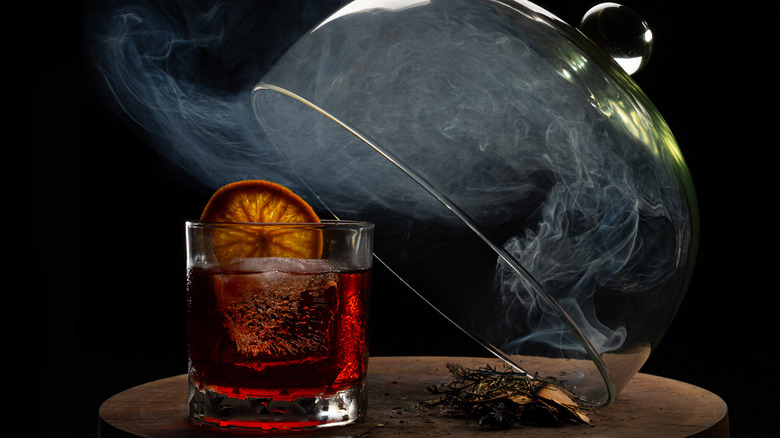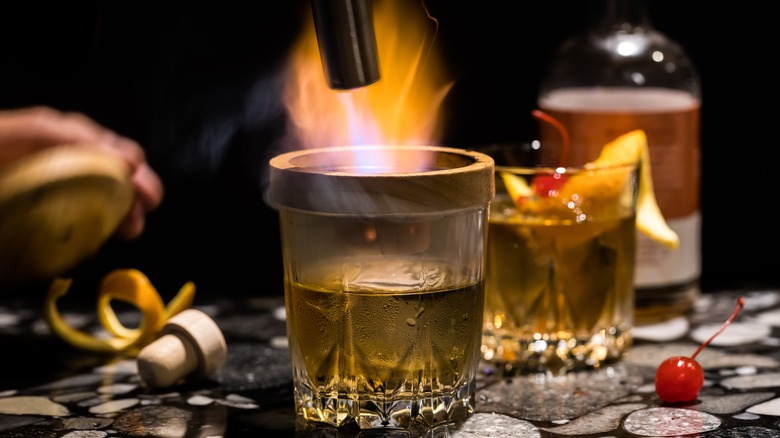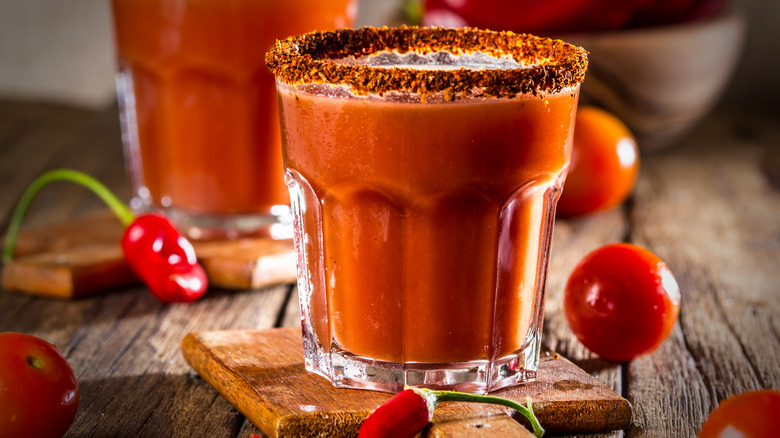It's Time To Start Wood-Smoking Your Cocktails
Who doesn't love a smoky whiskey on a chilly night, especially when it's a single malt scotch from the Scottish isles or a peaty bourbon from the hills of Kentucky? Actually, plenty of people turn their noses up at the smoky flavor of some whiskeys, according to Esquire, primarily when the smoke comes from peat-fueled fires when drying malted barley. Fortunately, peat isn't the only way to get a smoky cocktail you love. The secret is smoking the cocktail itself rather than using an inherently smoked spirit from the bottle.
Well-chosen woods, accompanied by natural materials such as herbs, spices, and even citrus peels, provide countless options for personalizing your smoke-infused cocktail creations, reveals VinePair. And it's not that hard to do, even at home. Igniting flavor passions in your glass comes down to artistry and technique. In addition to choosing the best materials, the process itself adds another layer to the complexity of your hand-crafted mixed drinks. Whether you're craving a Negroni cocktail, an Old Fashioned, or a twist on the classic Sazerac, here's a look at the fire-fueled world of wood-smoked cocktails and the subtleties involved in mixing things up.
Add flavored wood, bitters, or fruit to your cocktail
Wood is obviously essential in wood-smoked cocktails, but so are other offerings from Mother Nature. Many common edible items can add flavor to mixed drinks, notes Whisky Advocate, which encourages in-depth experimentation. For example, pecan wood can impart a nutty taste, while oak complements the barrel-aging process of whisky for a charred-wood flavor. But it's not just the wood; you can put a flame to anything from cinnamon to salt, rosemary, or chocolate bitters. Smoked vanilla beans lighten things up, while a garnish of smoked citrus peels allows a slow infusion while you savor every drop.
Fruits are a favorite ingredient for smoky cocktails, explains VinePair, especially tropical fruits such as mangos and pineapples, whose acids react well to smoke. You'll get smooth, pure flavor when the wood and fruit complement each other, easily achieved using wood chips from the same tree species as the fruit. For example, apple wood to smoke apples, and cherry wood to smoke cherries. Putting fire to vegetables is a quick way to enhance already existing ingredients in your go-to drink, such as smoking the tomatoes in your Bloody Mary.
Smoke-rinse or use a smoking gun
Now, for getting that wood-smoked flavor into your glass, options exist. Whisky Advocate zeros in on some basic methods, the first being a process known as smoke-rinsing the glass. It's the easiest way to impart a light smokiness to any drink without being an expert mixologist. Just choose your smoking ingredients and catch them on fire, using small amounts for a single drink. Then, flip a pre-chilled glass over your little bonfire. The smoke clings to the chilled insides of the glass, permeating the poured cocktail ingredients you add. A step up from smoke-rising an individual glass is to repeat the process with an entire glass pitcher for multiple drinks.
With a relatively small investment, the process gets easier with a smoking gun. Tasting Table follows New York City bartender Angela Laino in a step-by-step slide show on how to smoke cocktails using a smoking gun. She prefers heavy smoke flavor from woods like cherry bark or hickory but balances the heaviness with aromatic dried herbs or herbal teas. After adding smoked ingredients to her custom cocktails, she sometimes fills a glass globe with smoke and tops off the masterpiece, mostly to enhance the presentation.
Whichever method you choose, exercise diligence and care since you're working with some flammables, namely fire and alcohol. Work outside whenever possible, away from easily ignitable items such as paper napkins and loose strands of hair. Whisky Advocate also cautions against wearing loose clothing and advises taking a break if you're consuming while creating.


